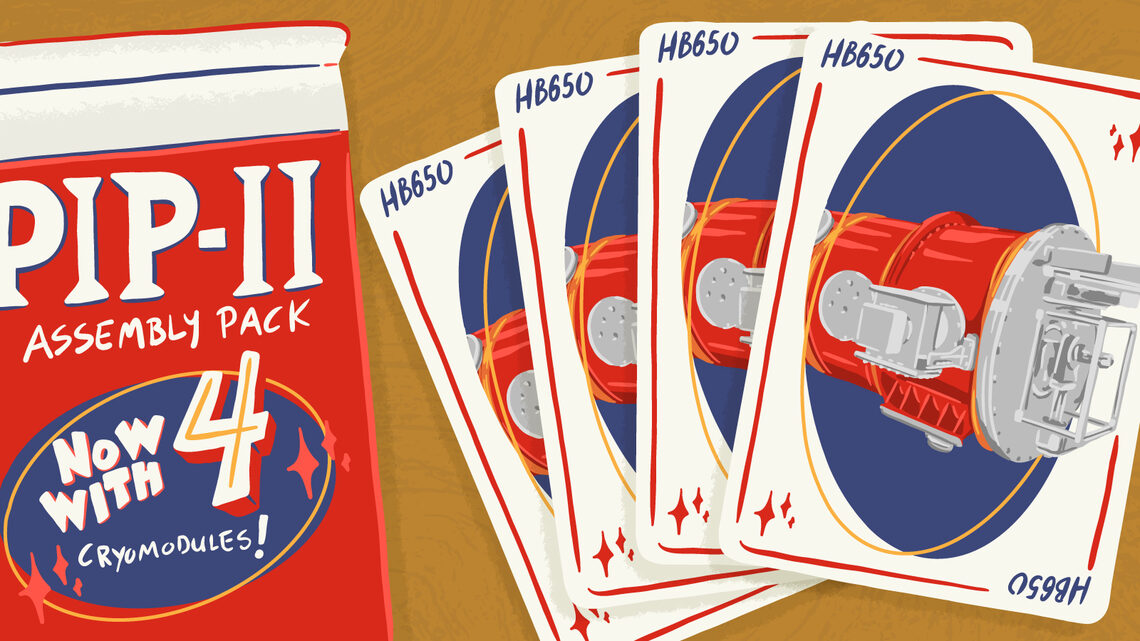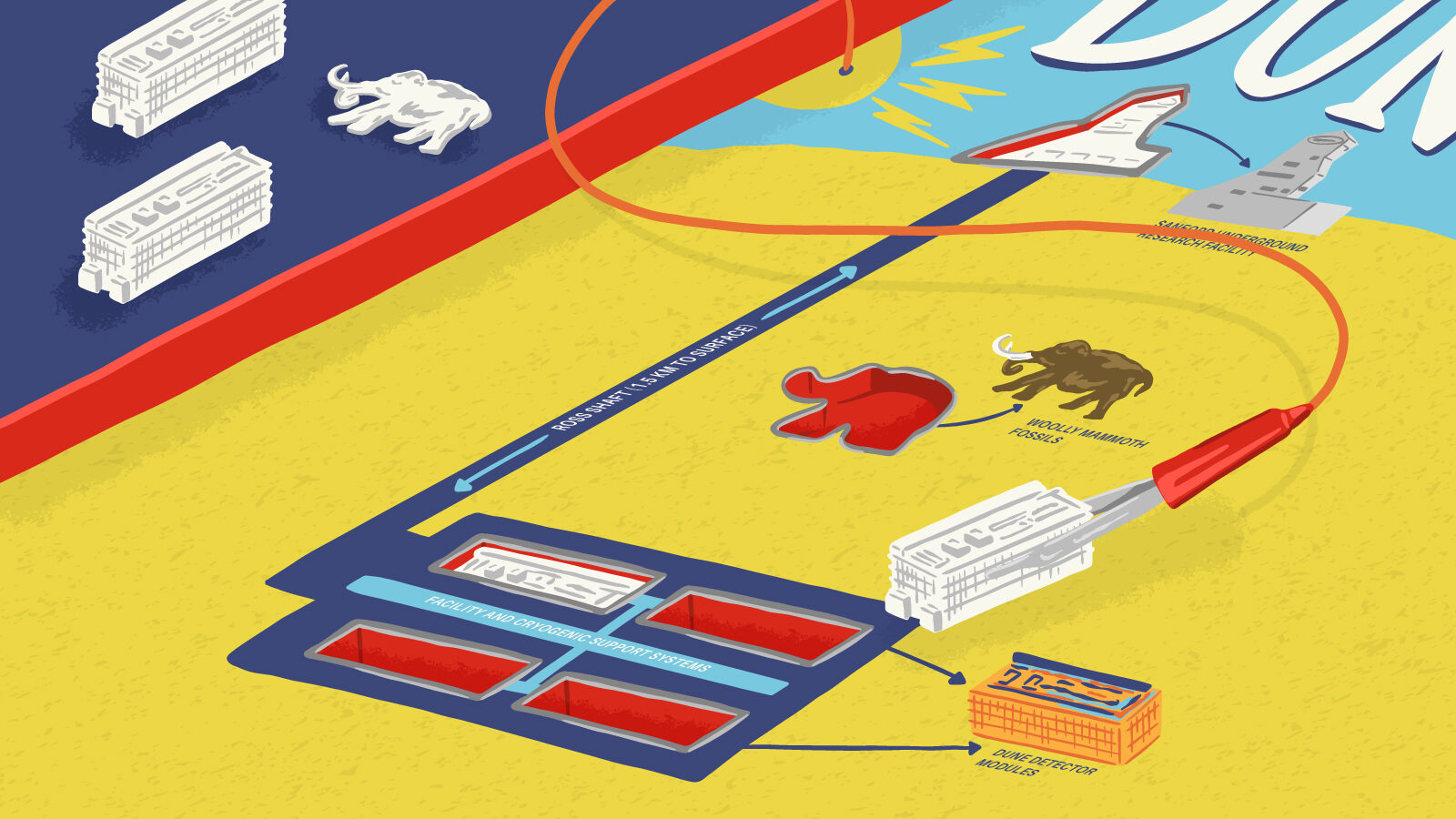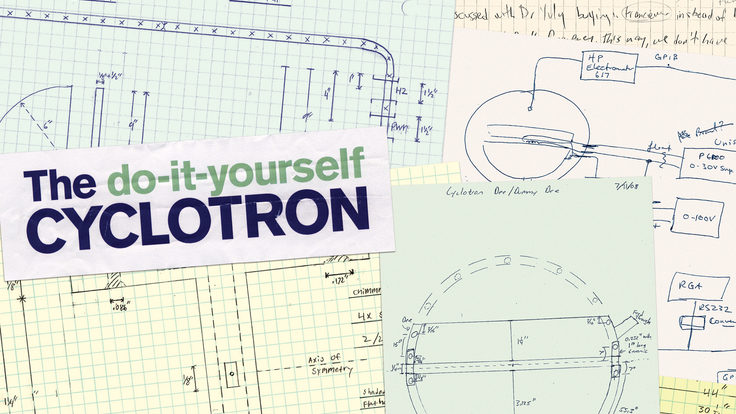When complete, the Deep Underground Neutrino Experiment, or DUNE, will be the world’s most comprehensive neutrino experiment—and installing the giant far detector for DUNE in a cavern a mile underground will be like the world’s largest game of Operation.
DUNE will consist of two detectors: a smaller near detector, to be located at the US Department of Energy’s Fermi National Accelerator Laboratory in Illinois; and a larger far detector, to be located at Sanford Underground Research Facility, or SURF, in South Dakota.
The far detector is designed to be made up of four modules—two of which are under construction, and two of which are still being planned—each the dimensions of an almost-six-story building and as long as a football field. One module will be made up of 25 rows of smaller neutrino detectors called anode plane assemblies—APAs—some of the experiment’s most fragile components.
With the DUNE far detector at SURF being assembled in an underground cavern, there is not much wiggle room to work. The technicians installing the final row of APAs will be up against a wall and will have just a couple of meters to safely operate in; once they bring in the scissor lift, there will be just enough room for a human to walk between it and the APAs. After they’re done, they will have to squeeze back through, bringing with them all the tools and instruments they brought in.
To finish the detector, “we are working with inches to spare,” says Tom Wieber, manager at another underground laboratory, NOvA Far Detector Facility in Ash River, Minnesota.
Wieber knows the constraints well, as he is playing an essential role in preparation for the final installation.
NOvA is also a long-distance neutrino experiment. It consists of a far detector in Ash River and a near detector at Fermilab. A beam of neutrinos originating at Fermilab is sent through both detectors.
Once NOvA was assembled, the Ash River facility had sufficient high-bay space to create a trial assembly area for DUNE; it is the only place with two prototype APAs that technicians can practice working with.
Prototyping is an indispensable step in the development of large particle physics experiments. From testing the components to confirm they will work in experimental conditions to rehearsing the transportation and assembly of pieces, particle physics collaborations go to great lengths to ensure that the experiment will perform as expected.
Many components of DUNE use specially developed tools that Wieber and his team fabricate in-house, based on design drawings and lists of materials. They then test the tools on their DUNE prototype.
“We have great engineers behind us who design the tools and fixtures in such a way that we just have to find out how to use them safely,” says Wieber. “Like, are they too heavy? Do we need another helper tool to make installation or removal easier? What sort of things need to be put on lanyards so that they don’t fall? At any point when you’re using this, is it impossible to use without three hands?”
When they run into a problem, Wieber’s team informs the engineers of the issue and proposes potential fixes. Then the design is revised, and the process starts again.
“I can probably count on one hand how many version-one widgets, tools, fixtures have not had some sort of modification after being tested—some of them simple, some of them totally reworked,” says Wieber.
“All of the lessons learned are valuable,” he says. “Anything that was difficult, time-consuming, whatever—it needs to be recorded. Because we’re building a prototype, and if there’s a problem…it needs to be documented so that when we go to scale this thing to kilotons, [the problem is] not compounded.”
Ash River’s setup is versatile enough that Wieber and his team can test many things at once. For example, they are installing their two APAs at different orientations to test cable length. Simultaneously, they are testing the “bendiness” of a cathode plane—to see whether it will straighten out after being held in a crescent-moon shape.
“The [cathode plane assemblies] at CERN are not hanging straight, so [the high-voltage consortium] asked us to perform this test because we have the only other hanging CPAs in existence,” Wieber says. “So, we said, yeah, we can.

Testing a new cryomodule
The detectors are not the only parts of DUNE that can benefit from a test run.
Tests of the DUNE detector components began in 2017 at CERN with a pair of one-twentieth-scale prototypes aptly called ProtoDUNE. Each ProtoDUNE detector used different liquid argon time-projection chamber designs, and both were instrumented with a small number of full-scale detector components.
And there’s the particle accelerator that will produce the beam of neutrinos the detectors will study. DUNE will be powered by a new superconducting linear accelerator at Fermilab, which is being built through the Proton Improvement Plan II, or PIP-II, project. The accelerator will comprise five different types of cryomodules that house and cool the superconducting cavities that will accelerate the particles to over 80% the speed of light.
The PIP-II team at Fermilab recently completed assembling a prototype of one of the cryomodules. Called the high-beta 650-MegaHertz, or HB650, cryomodule, it is the largest cryomodule in the accelerator; four HB650 cryomodules will make up the final stage of acceleration.
The team installed the prototype in a cryomodule test stand at Fermilab in January and February of 2023. The installation process required technicians to connect the prototype to its radio-frequency power source, instrumentation readouts and the cryogenic distribution system that will cool it to superconducting temperatures.
“This one being a prototype cryomodule, it is instrumented extensively with sensors—much more than what we would do in a typical production-phase cryomodule—so that we can observe, monitor and then use that information to validate our designs,” says Saravan Chandrasekaran, former PIP-II manager for the HB650 cryomodule at Fermilab, who led the assembly.
Even the cryomodule’s installation on its stand resulted in feedback on the cryomodule design. Chandrasekaran says both the stand and the cryomodule will likely change designs slightly to accommodate each other better.
“We work as one team,” he says. “We are all working toward getting an accelerator for our lab.”
In late February, the team received clearance to operate the prototype. And in early March, they began the “cooldown” process to test the cryomodule’s ability to reach the 2 Kelvin, or minus 456 degrees Fahrenheit, required for superconductivity.
“The prototype essentially serves as the best vehicle for us to test out all of the designs [and] confirm all of the interfaces to highlight any issues that might be inherently present and provide us an opportunity to address them prior to moving into the production phase,” says Chandrasekaran.
In mid-March, the PIP-II team reported that they successfully completed the prototype’s cooldown on the first try. The cryomodule had reached 2 K in less than six days with no technical issues. In April, the team put radiofrequency power into the first of six cavities. While there’s still lots of testing to be done, once the data comes in and is analyzed—and demonstrates the required performance—the team will feel more confident about this cryomodule design.
“They say the proof of the pudding is in the tasting,” says Joe Ozelis, who now manages the PIP-II HB650 cryomodule program. “Well, for us, the proof of the design is in the testing.”







